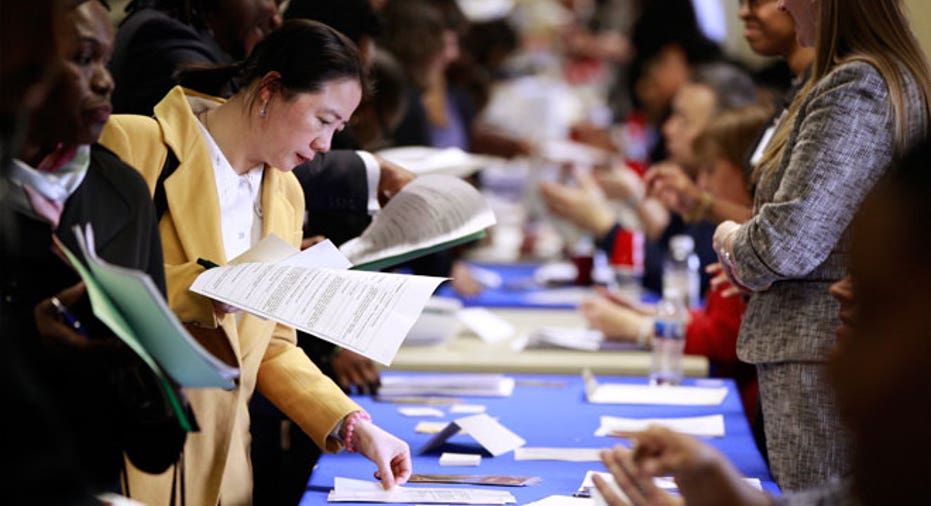U.S. Economy Adds More Jobs than Forecast in February

The U.S. added 295,000 jobs in February, another strong month of job creation that should add momentum to the Federal Reserve's tentative plans to raise interest rates later in 2015.
It was the 12th consecutive month in which the U.S. added more than 200,000 jobs, the strongest period of job growth in a decade and a half. The headline unemployment rate was 5.5%, its lowest level in six years, according to data released Friday by the Labor Department. Economists had forecast an addition of 240,000 jobs and that the unemployment rate would tick lower to 5.6%
"The upside surprise should no longer be a surprise because, despite what many pessimists wish to believe, the economy is expanding at a healthy clip and creating high variety jobs again,” said Todd Schoenberger, managing partner at LandColt Capital LP.
“To add to this, the household balance sheet continues to improve, thus helping sentiment numbers, which should increase spending in the second quarter and demand for labor. Look for continued improvement in big ticket purchases, such as homes, cars and durable goods in the months to come as the jobs picture continues to shine in 2015,” Schoenberger added.
Still, Fed policy makers are keeping a close eye on wage growth and the labor force participation rate, two economic indicators that have lagged in recent months even as job growth has gained steam and the unemployment rate has steadily declined. Wage growth and labor force participation both impact inflation and inflation has stubbornly remained below the Fed's target rate of 2% as those two indicators have lagged.
In February, average hourly earnings for all employees on private nonfarm payrolls rose by a slim 3 cents to $24.78, according to the Labor Department numbers. Over the past year, average hourly earnings have risen by 2 percent, or well below the 3% target economists say contributes to a healthy economy. In February, average hourly earnings of private-sector production and nonsupervisory employees were unchanged at $20.80.
The labor force participation rate was virtually the same as a month ago at 62.8%.
Weakness in wage growth and labor force participation has been caused by so-called slack in the jobs market, a condition cited repeatedly by Fed Chair Janet Yellen in her defense of maintaining an extremely accommodative monetary policy, namely near-zero interest rates.
Wages have been kept low because many temporary and part-time workers are available to step into fulltime jobs when they become available. Employers are aware of this surplus pool of job seekers and consequently they know they don't have to raise wages to attract employers. Labor force participation has hovered at its lowest levels since the 1970s because many people who lost their jobs during the deep 2009 recession that followed the financial crisis have stopped looking for work altogether rather than return to work at a part-time or temporary position. When someone stops looking for a job they are no longer counted by the government as part of the survey used to determine the unemployment rate.
But the string of recent strong jobs reports and a generally upbeat forward guidance by Fed economists which suggests the broader U.S. economy is healing has led to a strong conviction that the Fed is targeting mid-2015 for an interest rate hike, a conviction Fed officials have done nothing to deny.
Date released earlier this week by the Fed suggests the U.S. economy continued to expand across most regions and sectors from early January through mid-February, with auto sales and consumer spending rising in most Fed districts. In its Beige Book report of anecdotal information on business activity collected from contacts across the nation, the central bank said wage pressures were moderate across most districts. But the report said some areas reported wages rose in an effort to attract skilled workers for difficult-to-fill positions, hopefully a preview of a wider trend to follow.
Yellen and her colleagues have stated that a tightening jobs market will eventually push wages higher, which will in turn increase demand by consumers who are making more money leading to higher prices and a healthier inflation rate. The conventional wisdom is that this is all likely to occur in the second half of 2015 and into 2016.
The job gains in February were across the spectrum, according to the Labor Department, but notably in in food services and drinking places, professional and business services, construction, health care, and in transportation and warehousing
The Fed has said it won’t start raising interest rates until it reaches its dual mandate of full employment and price stability. The central bank has defined the former as an unemployment rate in a range of 5.2%-5.6% and the latter as an annual inflation range of 1.7%-2%.
The unemployment rate has now dropped into that desired range, but the inflation target is trickier. Inflation isn’t likely to move higher until wages go up significantly.
When rates do move higher it will be more expensive for consumers and businesses to borrow money. The higher costs for borrowing could cut back on consumer spending and business expansion, which could negatively impact labor markets. For those reasons the Fed has been cautious, to say the least, in its approach toward raising rates. In December, the central bank added language to its policy statement saying it could "be patient" as it formulated a plan for a rate liftoff. But that language is widely expected to be removed at its March meeting as economic conditions have continued to improve and the Fed lays the groundwork for the first rate hike in nearly a decade.